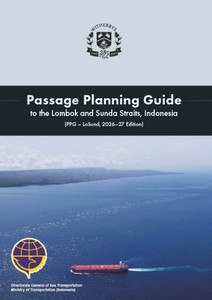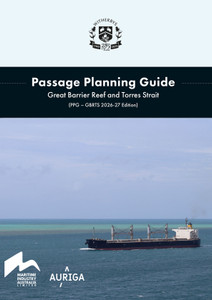
This publication is an essential resource for ships navigating the Danish Straits and provides guidance to aid Masters and navigating officers in the creation of passage plans for the transit.
The guidance applies in either direction through the Straits via the Great Belt and the Sound and includes an overview of the navigational references for each leg of the routes.
In cooperation with DanPilot and BIMCO, this new edition has been fully revised to incorporate the latest guidance and practical advice for ships transiting the region, with reference to important information such as pilotage, anchorages, reporting requirements and traffic.
This Guide provides information on essential passage planning practice, including elements local to the Danish Straits, to help navigating officers compile an effective passage plan. It includes practical guidance for the transit, with reference to traffic, pilotage, anchorages, tidal streams and climate, reporting requirements, bridge clearances, etc.
Annotated chartlets, which now feature satellite imagery, are provided for each leg of the transits of the Great Belt and the Sound, illustrating aids to navigation and potential hazards to shipping.
The Guide illustrates 'hotspot' areas where high vigilance is required and lists the pre-emptive measures that should be taken by the ship. Also included are a number of case studies that examine the causes of various groundings and collisions in the Straits.
This new edition now includes a section on guidance for Masters, which provides a helpful overview of important information for arriving ships, such as pilotage, communication, bunkering and STS operations. Significant updates and additions have been made to information regarding reporting systems and requirements, pilot ladder arrangements, traffic in the Straits and the Fehmarnbelt Construction Project.
In preparation for this new edition, Witherbys has worked in consultation with DanPilot, the pilot service of the Danish State, to fully revise and update the Guide.
The Baltic Sea and the Danish Straits is an area of great environmental and economic importance and the IMO has declared it a special area under MARPOL since 1989.
In 1974, the HELCOM Convention was signed by the countries bordering the Baltic Sea, seeking to protect the Baltic Sea from all pollution from land, air and sea.
Since 1975, the IMO has developed various recommendations for safe passage in the Danish Straits. Today, IMO Circular SN.1/Circ.263, which recommends the use of a pilot in the Danish Straits Route T and the Sound, has been adopted.
Passing the Danish Straits, either by the Great Belt or the Sound, leads ships through shallow water, strong currents, harsh weather conditions and high density of traffic, making it a complex challenge for mariners.
The Passage Planning Guide - Baltic Sea: Danish Straits has been developed through cooperation between Witherbys, DanPilot and BIMCO to provide an overview for mariners and to assist in proper planning for a ship
transiting in this area.
The information in this Guide has been cross-checked and validated by pilots from DanPilot, using their extensive experience in navigating these high risk areas.
DanPilot recommends all mariners planning a transit through the Danish Straits to use this Guide as a valid tool for pre-entry procedures or as a document for refreshing and familiarising the bridge team with a passage through the area. The design of the Guide allows the mariner to maintain an overview during the passage.
Erik Merkes Nielsen
CEO/Adm. Direktør
Foreword
Acknowledgements
Notices
Glossary
Note on Spellings
Baltic Sea Chart Datum (BSCD2000)
Explanation of Routes Shown on the Chartlets in this Guide
Part 1 Background and Supporting Notes to the Guide
Limits and DW Routeing
Part 2 Case Studies, Groundings, Collisions and Traffic Hotspots
Part 3 Passage Notes - Inbound: Skagen to Bornholm
Southbound via Great Belt
Southbound via The Sound
Passage Notes - Outbound: Bornholm to Skagen
Northbound via Great Belt
Northbound via The Sound
Part 4 Annexes
Pre-Entry Bridge Team Meeting
SAR Contact Details
TMAS Contact Details
Witherbys
Witherbys titles are developed using scripts developed by technical experts that are peer reviewed within work groups. Typically, they seek to improve understanding of the regulations, recommendations and guidelines issued by Industry.
Witherbys staff have significant expertise in the fields of navigation and hazardous cargoes as well as in the presentation of complex subjects in a graphic and easy to understand manner.
DanPilot
The pilots of DanPilot are easily recognised by the crown adorning the uniform, symbolising that DanPilot is the pilot service of the Danish state. All pilots are approved and certified by the Danish Maritime Authority and possess a solid background from the merchant marine.
BIMCO
BIMCO is the world's largest direct-membership organisation for shipowners, charterers, shipbrokers and agents. In total, around 60% of the world's merchant fleet is a BIMCO member, measured by tonnage (weight of the unloaded ships).
The organisation has NGO status and is based in Copenhagen, Denmark, with offices in Athens, Singapore and Shanghai.
With around 1900 member companies across 120 countries, from the largest shipowners in the world to small local port agents and law firms, BIMCO represents a wide range of maritime companies and organisations.
BIMCO's goal is to secure a level playing field for the global shipping industry. BIMCO therefore works to promote and secure global standards and regulations for the maritime sector. The organisation's century long effort into creating standard contracts and clauses is an expression of that aim.
- Number of Pages:
- 148
- Published Date:
- March 2025
- Book Height:
- 297 mm
- Book Width:
- 210 mm
- Weight:
- 2 kg
- Publication Date:
- March 2025
- Author:
Witherbys, DanPilot & BIMCO
- ISBN:
- 1917308416
- Preview:
- Yes






